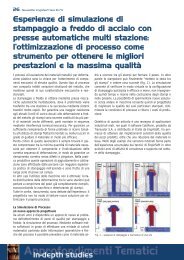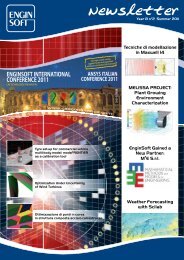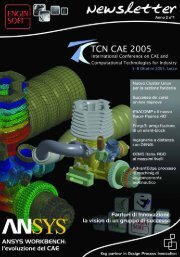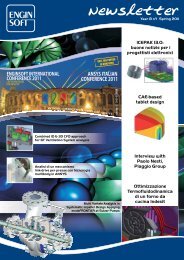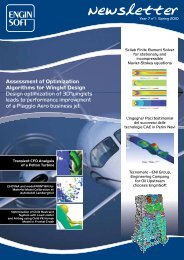software training courses 2010 corsi di addestramento ... - EnginSoft
software training courses 2010 corsi di addestramento ... - EnginSoft
software training courses 2010 corsi di addestramento ... - EnginSoft
Create successful ePaper yourself
Turn your PDF publications into a flip-book with our unique Google optimized e-Paper software.
Pict. 4.1.1 – modeFRONTIER’s workflow<br />
Picture 4.2.1 – History chart SX<br />
block XY <strong>di</strong>splacement. The constraint con<strong>di</strong>tions have to be<br />
understood with a little tolerance in <strong>di</strong>splacement. In fact,<br />
every constraint allows a clearance to avoid stress<br />
concentration due to an over- constrained con<strong>di</strong>tion.<br />
Applying the temperature field to the modeled system as<br />
described before, we continue with the structural simulation<br />
to calculate the stress on and the deformation of the examined<br />
component.<br />
In order to avoid value <strong>di</strong>stortion, due to mesh problems,<br />
instead of considering maximum and minimum values, we<br />
have taken into account a mean value of this quantity close<br />
to the glass constraints.<br />
4 Optimization of the glass support<br />
The initial model described previously has been parametrized<br />
to allow the management by modeFRONTIER; the described<br />
parameters refer to the <strong>di</strong>mensions of the upper and lower<br />
glass constraints. While we focused on these constraints, the<br />
<strong>di</strong>stances from the left and right glass edges and their width<br />
were parametrized.<br />
The aim of this step was to define an optimum set-up of the<br />
constraint system that minimizes the glass deformations in<br />
pyrolysis con<strong>di</strong>tions.<br />
Newsletter <strong>EnginSoft</strong> Year 6 n°4 - 19<br />
4.1 Project set-up in modeFRONTIER<br />
Variables used in this first optimization sub-step are therefore<br />
four and each couple refers to the <strong>di</strong>mension of a constraint.<br />
The constraints on the glass are four, symmetrical, and hence<br />
it is sufficient to mo<strong>di</strong>fy the <strong>di</strong>mensions of only one to mo<strong>di</strong>fy<br />
the couple: these will be the variables of the optimization.<br />
Lower and upper bounds of all the variables were set accor<strong>di</strong>ng<br />
to the customer’s requirements.<br />
By using modeFRONTIER, we want to manage the entire FEM<br />
(ANSYS) process automatically, to obtain the desired results.<br />
To interface the FEM model with the optimizer, some macros<br />
were built, or rather a series of pre- and post-processing<br />
instructions to mo<strong>di</strong>fy the geometry of the model during each<br />
simulation.<br />
During the set-up of the optimization, some factors, such as<br />
time for each calculation or maximum available time have to<br />
be taken into account in order to define the best strategy.<br />
In this project, the time for each calculation was about 75<br />
minutes, not negligible; this made us choose a genetic<br />
algorithm that has a good robustness to find the optimum.<br />
The objectives were:<br />
Minimization SXZ shear stress;<br />
Minimization SX normal stress;<br />
Minimization SZ normal.<br />
The chosen algorithm was the MOGA (Multi Objective Genetic<br />
Algorithm), starting from an initial random population (DOE)<br />
of the input variables domain.<br />
Simulation parameters:<br />
MOGA iterations: 10<br />
DOE <strong>di</strong>mensions: 12 - variables number multiplied for<br />
objectives<br />
With these settings we have to do 120 runs for a total run<br />
time of 150 hours<br />
4.2 Optimization results<br />
After the optimization process, a good convergence of results<br />
was achieved: values of shear and stresses decreased up to<br />
40% with respect to the original configuration.<br />
Picture 4.2.1 shows an example of the history charts of<br />
stresses SX.<br />
As this is a multi-objective optimization, optimum results are<br />
more than one: in fact, we could have some designs which<br />
achieve the first objective, but are very far from the other<br />
objectives. Hence we are looking for the best tradeoff!<br />
In this job, all three objective are very correlated, so the<br />
convergence is parallel, which allows us to choose two<br />
optimal designs.<br />
From the obtained results we can extract some important<br />
information about the component behavior in real working<br />
con<strong>di</strong>tions, especially with regard to the glass constraints<br />
<strong>di</strong>mension and their <strong>di</strong>spersion across the oven door:<br />
Distance of the lower constraint from the edge of the<br />
glass seems to have no influence on stresses;<br />
Width of lower constraint should be bigger than original;<br />
Distance of the upper constraint from the edge of the<br />
glass seems to have no influence on stresses;<br />
Width of upper constraint should be smaller than original;



